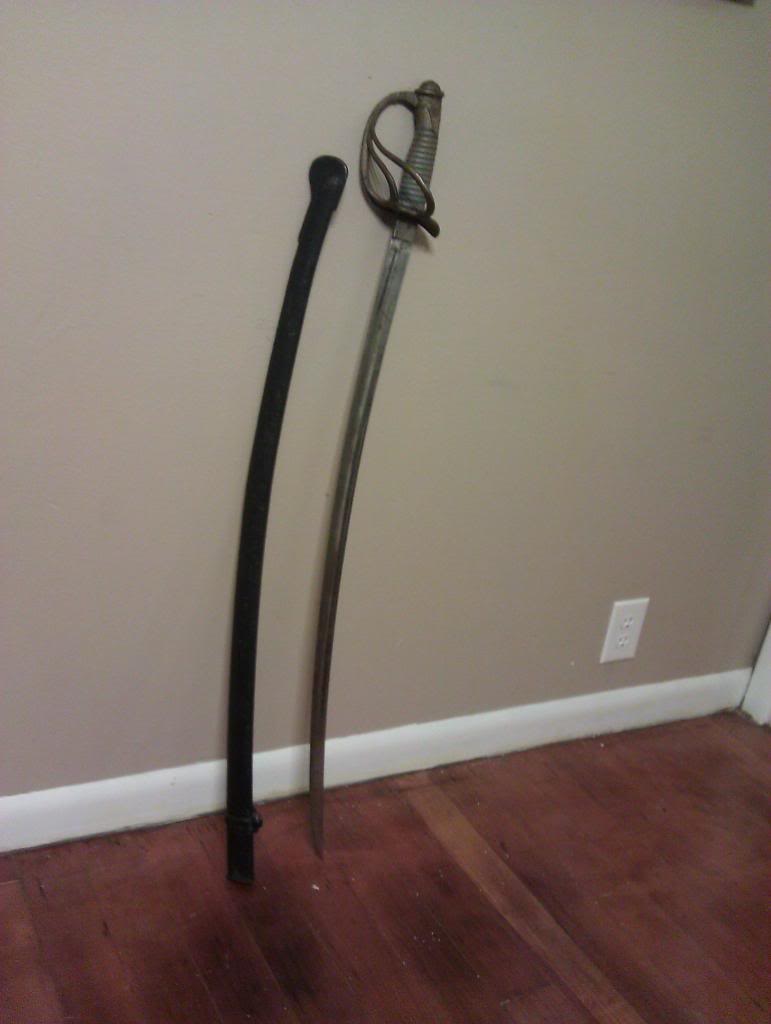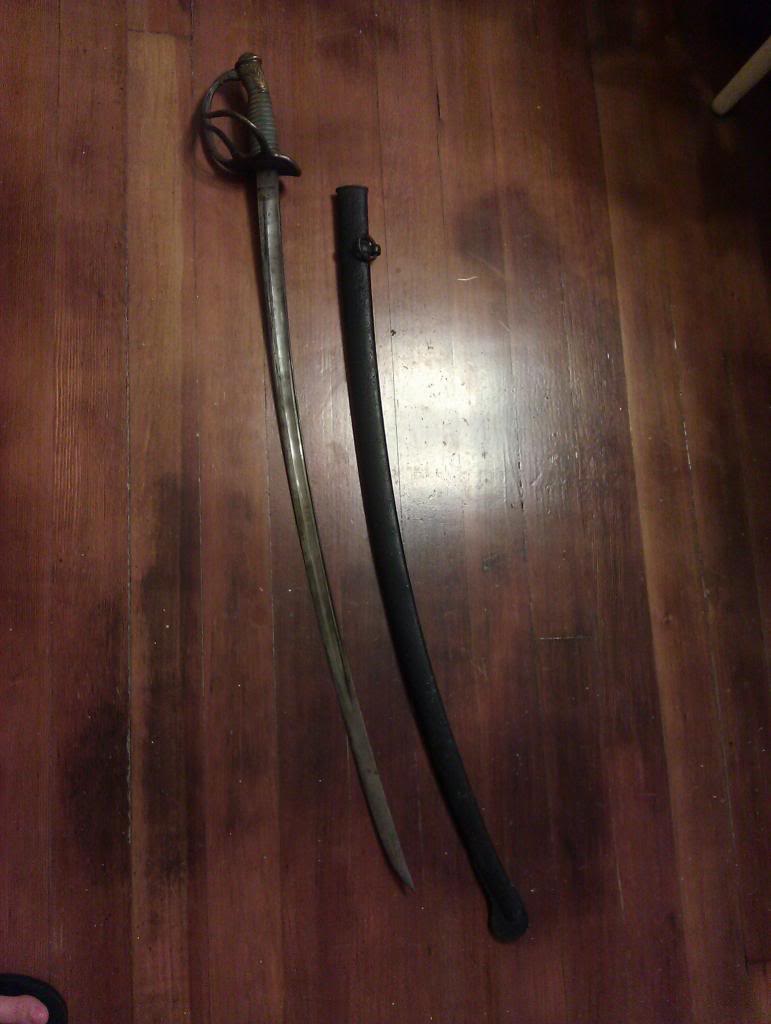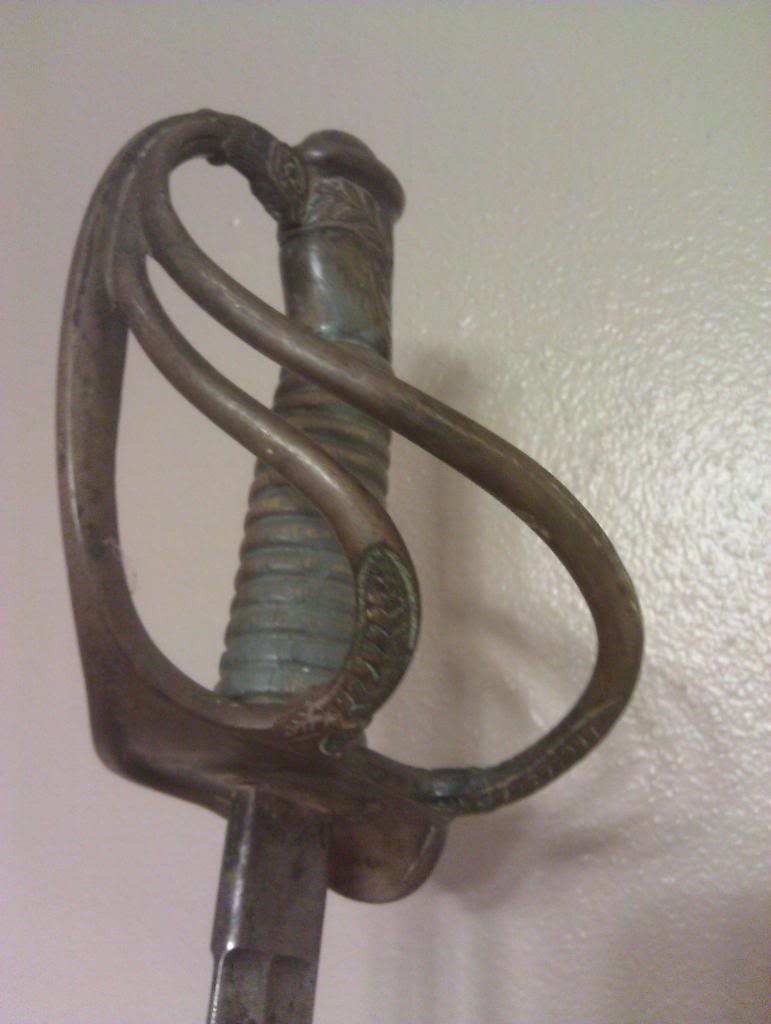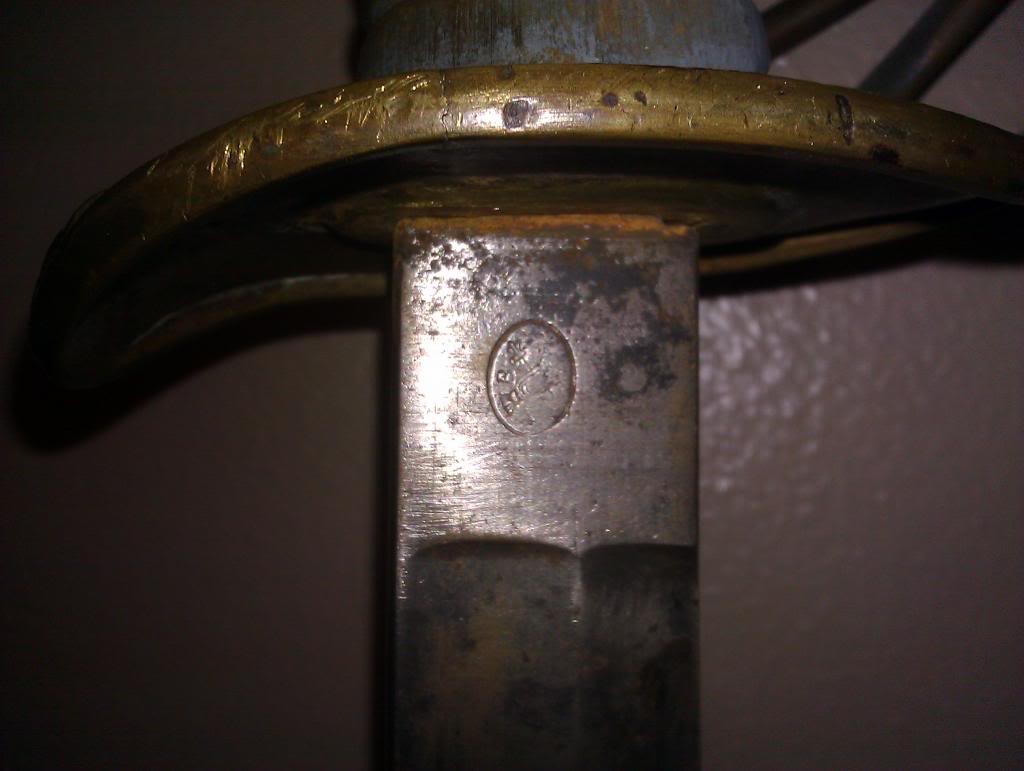| Author |
Message |
|
Brandon P
|
 Posted: Wed 18 Dec, 2013 10:10 am Post subject: Need help identifying a cavalry sword Posted: Wed 18 Dec, 2013 10:10 am Post subject: Need help identifying a cavalry sword |
 |
|
I got this from my dad, who got it for mowing a guy's lawn in the '60's. Any help in identifying the sword would be greatly appreciated.
Thanks!





|
|
  |
 |
Ian Hutchison

Location: Louisiana / Nordrhein-Westholland Joined: 27 Nov 2007
Posts: 626
|
 Posted: Wed 18 Dec, 2013 10:17 am Post subject: Posted: Wed 18 Dec, 2013 10:17 am Post subject: |
 |
|
I would say it looks like a US Model 1860 light cavalry saber. The 1860 looks a lot like the model 1840 cavalry saber it replaced, if you had the dimensions, I could tell you with more certainty which.
Best,
Ian
'We are told that the pen is mightier than the sword, but I know which of these weapons I would choose.' - Adrian Carton de Wiart
|
|
  |
 |
|
Brandon P
|
 Posted: Wed 18 Dec, 2013 10:27 am Post subject: Posted: Wed 18 Dec, 2013 10:27 am Post subject: |
 |
|
Thanks! I'll have the wife take some measurements since she's at home right now. Out of curiousity, it's in pretty bad shape, and I was thinking about polishing it up; is this a good idea, and how should I go about doing it if it is?
Thanks,
BrandonP
|
|
  |
 |
|
Brandon P
|
 Posted: Wed 18 Dec, 2013 11:01 am Post subject: Posted: Wed 18 Dec, 2013 11:01 am Post subject: |
 |
|
Blade length=35"
Blade width at base = 1.25"
|
|
  |
 |
Glen A Cleeton

|
 Posted: Wed 18 Dec, 2013 12:28 pm Post subject: Posted: Wed 18 Dec, 2013 12:28 pm Post subject: |
 |
|
A French mle1822 type officer's sword. As it does not show any French poincons, it was likely Prussian made and a style used continent wide. With the single scabbard ring, I would think later than the 1882 period.
The US light cavalry sword, there really was no designated 1860 aside from 20th century historians. The first federal contracts for the "light" were fulfilled in 1858 by Ames., so it is wrong (in the absolute) to call them the M1860 (please show me in an ordnance book if you can find them listed as the M1860). It is a losing battle to convince the modern collector that is the case but it is simply the light cavalry sword in name and contract. There was an M1906, which mimics the light (1860 sic) that was pretty much the same sword but with a steel hilt.
More later, if there is any interest.
Cheers
GC
|
|
  |
 |
Tom King

|
 Posted: Wed 18 Dec, 2013 12:57 pm Post subject: Posted: Wed 18 Dec, 2013 12:57 pm Post subject: |
 |
|
| Brandon P wrote: | Thanks! I'll have the wife take some measurements since she's at home right now. Out of curiousity, it's in pretty bad shape, and I was thinking about polishing it up; is this a good idea, and how should I go about doing it if it is?
Thanks,
BrandonP |
DO NOT POLISH IT
patina=value, just like every american roadshow and pawn stars episode stresses. You'll ruin the piece if you scotch bright it into oblivion.
|
|
  |
 |
|
Brandon P
|
 Posted: Wed 18 Dec, 2013 1:01 pm Post subject: Posted: Wed 18 Dec, 2013 1:01 pm Post subject: |
 |
|
|
So one vote for a US sword, and another for a French one. Any other votes?
|
|
  |
 |
|
Brandon P
|
 Posted: Wed 18 Dec, 2013 1:04 pm Post subject: Posted: Wed 18 Dec, 2013 1:04 pm Post subject: |
 |
|
DO NOT POLISH IT
It has some rust, and is very tarnished.
|
|
  |
 |
Ian Hutchison

Location: Louisiana / Nordrhein-Westholland Joined: 27 Nov 2007
Posts: 626
|
 Posted: Wed 18 Dec, 2013 1:56 pm Post subject: Posted: Wed 18 Dec, 2013 1:56 pm Post subject: |
 |
|
Glen, I will readily yield to your knowledge on this subject, and you are of course correct about the US light cavalry saber. Though, the 1860 nomenclature is in almost universal (if inaccurate/lamentable) usage and makes search/discussion less ambiguous.
However, it seems to me that the large ricasso is typical of the swords made for American contracts and a feature which I cannot say I've seen on a French M1822? Also, do you recognize the mark on the ricasso?
Brandon, don't polish it. As with any antique, preservation/originality are key. If you want to care for it, feel free to oil it or protect it with a wax.
'We are told that the pen is mightier than the sword, but I know which of these weapons I would choose.' - Adrian Carton de Wiart
Last edited by Ian Hutchison on Wed 18 Dec, 2013 2:18 pm; edited 2 times in total
|
|
  |
 |
|
Brandon P
|
 Posted: Wed 18 Dec, 2013 2:03 pm Post subject: Posted: Wed 18 Dec, 2013 2:03 pm Post subject: |
 |
|
Sorry, when I was referring to polishing, I was meaning removing the tarnish and rust, not making the metal shine. Is it better to leave the rust and just oil it?
I should also mention that my dad tried to sharpen it as a kid, and he did an awful job at it.
|
|
  |
 |
Ian Hutchison

Location: Louisiana / Nordrhein-Westholland Joined: 27 Nov 2007
Posts: 626
|
 Posted: Wed 18 Dec, 2013 2:15 pm Post subject: Posted: Wed 18 Dec, 2013 2:15 pm Post subject: |
 |
|
| Brandon P wrote: | Sorry, when I was referring to polishing, I was meaning removing the tarnish and rust, not making the metal shine. Is it better to leave the rust and just oil it?
I should also mention that my dad tried to sharpen it as a kid, and he did an awful job at it. |
Sure, if you can wipe off the active rust with an oily/silicon cloth, that's fine. Just don't go at it too aggressively. Glen knows a lot about these swords, he would probably be the best bet for a positive ID.
'We are told that the pen is mightier than the sword, but I know which of these weapons I would choose.' - Adrian Carton de Wiart
|
|
  |
 |
Glen A Cleeton

|
 Posted: Wed 18 Dec, 2013 3:13 pm Post subject: Posted: Wed 18 Dec, 2013 3:13 pm Post subject: |
 |
|
| Ian Hutchison wrote: | Glen, I will readily yield to your knowledge on this subject, and you are of course correct about the US light cavalry saber. Though, the 1860 nomenclature is in almost universal (if inaccurate/lamentable) usage and makes search/discussion less ambiguous.
However, it seems to me that the large ricasso is typical of the swords made for American contracts and a feature which I cannot say I've seen on a French M1822? Also, do you recognize the mark on the ricasso?
Brandon, don't polish it. As with any antique, preservation/originality are key. If you want to care for it, feel free to oil it or protect it with a wax. |
The 1822 officer's swords were often a good bit lighter than the trooper's swords and you can see that in the "hump" of the grip for the Ames (and some other's) take on the lighter mle1822 form. You will see the longer ricasso on those officer's swords with the lighter blades. I do not recognize the mark and as mentioned, do not see any French arsenal poincons. Both the trooper and officer swords of this type were (as mentioned) popular across the continent of Europe. Adding 3 and 5 I kind of come up with very possibly Prussian made in the form of an mle1822 officer's sword. Again probably late in the 19th century and in no way connected to the American Civil War. Belgian use mebbe, or even a privavte cutler's effort for a Frenchman but French cutlers use poincons on the hilt. as well as the arsenal poincons from the blade source. Really, I cannot stress enough that it is a European officer's sword in the style of the mle1822.
As to cleaning, it is really a matter of option and best tricks to conserve and preserve a sword. I got one sword from someone claiming only cleaning and preserving with rags and paste wax the only way to go. The item I received from him was literally rusting away under the paste wax after the decades he had owned (yes, red rust under the wax).
Another sword in this context a generic "wristbreaker I bought from Fagan Arms.

after some careful cleaning and preservation


Cleaned, not buffed but a great deal of work to strip off the soot and creosote encrusting that baby. Pecard's antique formula on the grip (some will shriek that only lanolin or neetsfoot may be used).
There are a number of sword conservation and preservation articles on the net and many will have their very own little shop of horrors. Shoe polish mixed with coffee grounds and super glue just one example of a fairly seamless fix here on brown horn. Another outstanding result with "patinated" polystyrene pellets and super glue to fill a section of rayskin..
Less can be more if unsure where to start in cleaning and a rag damp with light oil will do no harm to the metal parts.
Cheers
GC
In addendum, I would ask if the grip is wood or horn?
Last edited by Glen A Cleeton on Wed 18 Dec, 2013 3:28 pm; edited 1 time in total
|
|
  |
 |
|
Brandon P
|
 Posted: Wed 18 Dec, 2013 3:27 pm Post subject: Posted: Wed 18 Dec, 2013 3:27 pm Post subject: |
 |
|
Glen,
Thanks for all of the useful information! I think that the grip is actually the same material as the hilt. I'm not positive, but I'll double check that it isn't wood. Did you use anything on the blade to restore it?
|
|
  |
 |
Glen A Cleeton

|
 Posted: Wed 18 Dec, 2013 3:40 pm Post subject: Posted: Wed 18 Dec, 2013 3:40 pm Post subject: |
 |
|
Hi Brandon, the blade on the sword shown was fairly immaculate and the only reason I bought it while knowing there was work ahead.
Some are now touting light oil and aluminum foil (lots of it) to gently scrub. Very fine steel wool and light oil. I use Liquid Wrench but ventilate and use gloves, along with both green and blue kitchen scrubbies. Copper wool (Chore Boy) from the kitchen section as well...My tool bag would make a lot of folk upset but the trick is depth. Even fine automotive grit paper gets used here.
We are not looking at a crown jewel of a sword here, so keep that in perspective.
The reason I ask if what we see is horn is that it would be more possibly a French made sword.......but........most French made 1822 type blades will have an unstopped fuller ala this example
http://d1q1tydbf3ejpe.cloudfront.net/objet/20...rbe_1N.jpg
Could still be a French cutler with a Prussian blade. Still, with the single ring scabbard later than mid century.
Cheers
GC
|
|
  |
 |
|
Brandon P
|
 Posted: Wed 18 Dec, 2013 3:44 pm Post subject: Posted: Wed 18 Dec, 2013 3:44 pm Post subject: |
 |
|
Glen,
Realizing that the sword isn't a gem is why I was thinking about bringing back some of its original beauty. I've seen people use very light automotive sandpaper, and I think that might be the angle that I take. My aim is more of an heirloom piece, so I'd like it to last.
Brandon
|
|
  |
 |
Glen A Cleeton

|
 Posted: Wed 18 Dec, 2013 4:02 pm Post subject: Posted: Wed 18 Dec, 2013 4:02 pm Post subject: |
 |
|
Here is a a better look at a couple of mle1822 French made sabres (note use of poincons and unstopped fuller)
http://swordscollection.blogspot.com/2012/02/...-1822.html
A remark there about the single ring suspension in French vogue 1887.
Matt Easton still has his ricasso 1822 for sale, or at least has not closed it out but note no markings at all. A British buyer/owner. Again my conclusion would be Prussian made in teh style (and sor egarded) as the mle 1822 officer's sword.
http://www.swordforum.com/forums/showthread.p...er-s-sabre
Cheers
GC
I know, none are exactly like the sword of this thread
|
|
  |
 |
Glen A Cleeton

|
 Posted: Wed 18 Dec, 2013 4:04 pm Post subject: Posted: Wed 18 Dec, 2013 4:04 pm Post subject: |
 |
|
Careful repolishing with fine papers can remove a lot of haphazard sharpening scratches. Keep in mind that they only disappear when you go to the depth of them.
Cheers
GC
|
|
  |
 |
|
Brandon P
|
 Posted: Wed 18 Dec, 2013 4:07 pm Post subject: Posted: Wed 18 Dec, 2013 4:07 pm Post subject: |
 |
|
|
I wish I knew more about where the owner of the sword got it before my dad. He got it in Colorado, I wonder how it got there...
|
|
  |
 |
Glen A Cleeton

|
 Posted: Wed 18 Dec, 2013 4:14 pm Post subject: Posted: Wed 18 Dec, 2013 4:14 pm Post subject: |
 |
|
| Brandon P wrote: | | I wish I knew more about where the owner of the sword got it before my dad. He got it in Colorado, I wonder how it got there... |
Ha, I lived in Colorado for nine years but that is not where I started out.
Some like the fine details available in tracing the specifics such as original owner/user but my interests are more about history and the swords overall. Some will and do assign value in having the entire pedigree. My wild guess would be a war trophy from WWI or WWII. Lots of foreign swords end up in the US and unfortunately, a great many then get attached to a story about the family American Civil War possibilities.
Cheers
GC
|
|
  |
 |
|
Brandon P
|
 Posted: Thu 19 Dec, 2013 10:03 am Post subject: Posted: Thu 19 Dec, 2013 10:03 am Post subject: |
 |
|
Glen,
The grip appears to be made of wood.
|
|
  |
 |
|
|

